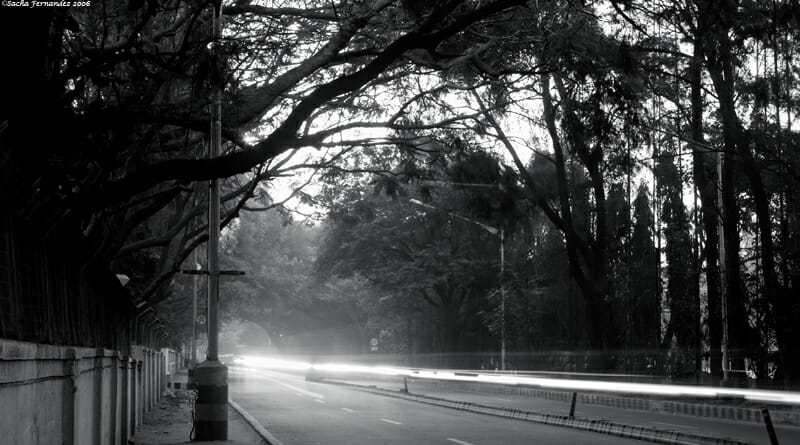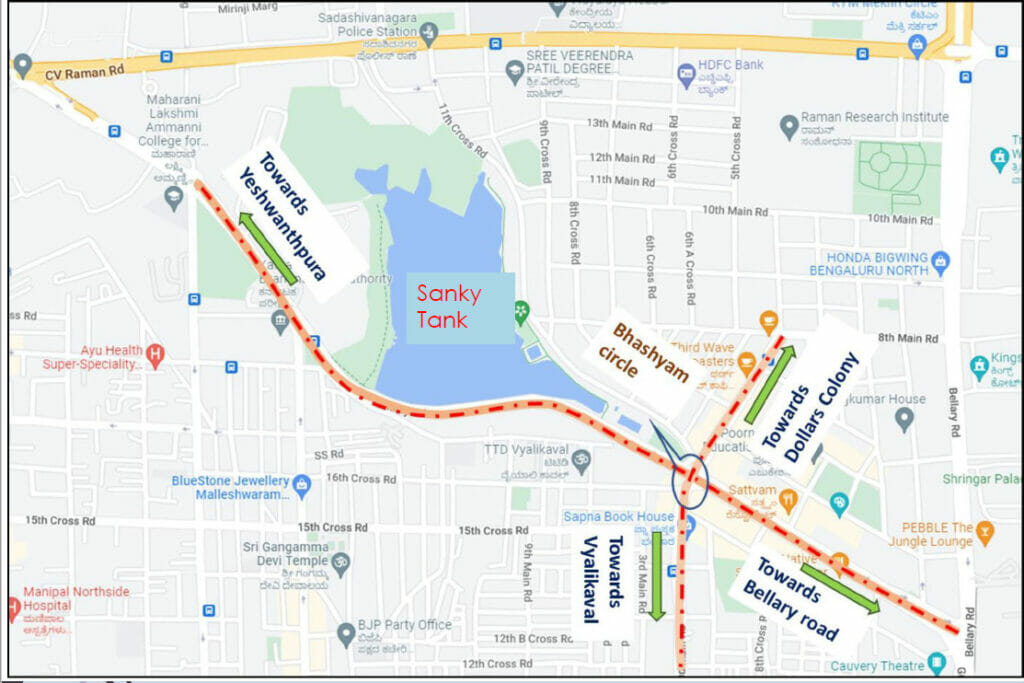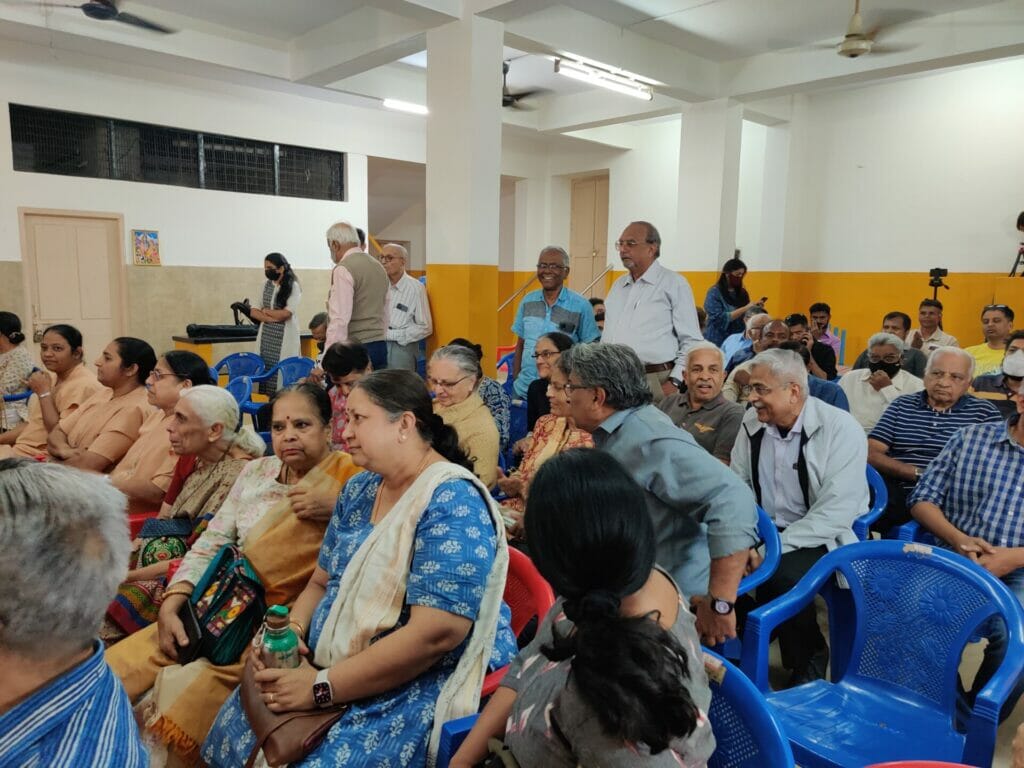City officials have been thinking of widening Sankey road for 40 years. However, their plans for easing traffic congestion around this busy junction has been largely criticised. Those opposing the move to widen Sankey road are concerned about the loss of 100-year-old trees, footpaths, the safety of the tank bund, as well as increased traffic and pollution.
The plan appears to go dormant every decade, but refuses to die.

Four decades in the making
In 1984, the city’s first Master Plan included a proposal to widen Sankey road. Although unopposed, the plan never went through. It was also mentioned in the 1995 Master Plan, but was not pursued even then.
In 2008, the Kempe Gowda International Airport opened in Devanahalli. Commuters from Central Bengaluru had to pass through the Cauvery Theatre junction on Palace Guttahalli road and eventually join Hebbal flyover to go to the airport. In the other direction, commuters from West Bengaluru could go past Sankey road and Bhashyam Circle and join Palace Guttahalli road at the same Cauvery Theatre junction, and eventually the Hebbal Flyover.
The same year, BBMP installed a pre-fabricated underpass called the “magic box” at the Sadashivnagar side of Sankey road at the Cauvery Theatre junction. The underpass was meant to prevent traffic going from Sankey Road to Central Bengaluru from clashing with traffic moving towards Bellary Road from Central Bengaluru.
In 2009, BBMP also opened up the Yeshwanthpur Flyover, which led to Malleshwaram and then, via Sankey road and Mekhri circle, connected to Bellary road. This meant a lot of traffic from Yeshwanthpur flyover, as well as Central Bengaluru, were clogging up the Cauvery Theatre junction as well as Bhashyam Circle.
Meanwhile, a study by the Directorate of Urban Land Transport (DULT), published in 2013, found that the magic box was a failure. The underpass was too steep, making it difficult for vehicles to turn safely. The narrow width increased congestion at the entry and exit points. Moreover, the poorly constructed box was full of leaks.
Sankey road widening in 2011
Thus in 2011, the BBMP decided that the route needed some big interventions. They decided to widen roads after the Yeshwantpur Flyover till the Cauvery Junction. This included the Sankey tank road to Bhashyam Circle stetch and Malleshwaram 18th Cross, and make the entire route signal free. Several residents of the area protested against the project and petitioned the Karnataka High Court.

The petitioners, part of a Residents’ Welfare Association called Malleshwaram Swabhimana Initiative, pointed out to the court that the project was not listed in the 2015 Masterplan. They also stated that BBMP held no public consultations despite the project leading to the loss of 400 trees, the risk of the Sankey tank bund being damaged, and pedestrians being endangered by signal free traffic flow.
The Karnataka High Court, however, ruled in BBMP’s favour, citing that environment had to be balanced with development. The court also ordered the civic body to ensure the safety of the tank bund, build pedestrian friendly roads, and plant more trees.
Latest iteration of the project
Despite this victory, BBMP only widened the road till the CNR Rao circle. In 2019, the civic body announced that they would widen the Sankey Tank main road up to Malleshwaram 18th cross. The road width would be increased from 27 to 30 metres. In 2022, perhaps as the pandemic began easing, the civic agency turned once again to this project and added a flyover to the mix.
According to the Detailed Project Report, Sankey road would become a four lane road. There would also be a 560 metre-long flyover from Bhashyam circle leading to Bellary road. Residents of the area found out that the work was going ahead only when BBMP issued tender notices at the end of 2022. As in 2011, BBMP did not inform residents or attempt any public consultations.
Once residents around the area learnt of the project they appear to have wasted no time. The concerns were the same as 2011: the loss of greenery and footpaths to road widening; the danger to the Sankey tank bund, which had already developed cracks in 2022; and the diversion of traffic to residential and school roads during the construction period. However, this time the movement seems to have focused on raising more awareness and garnering public support.
A citizens’ movement
They formed a group called Citizens for Sankey and asked for experts to analyse the project. Ashish Verma, a sustainable mobility researcher, from The Indian Institute of Science (IISc), examined the Detailed Project Report. Ecologists Harini Nagendra and Seema Mundoli from Azim Premji University and Vijay Nishanth, urban conservationist at Vruksha Foundation, conducted a rapid environment impact assessment, which was missing from the BBMP’s process. The EIA noted that at least 55 old growth trees would be cut.
Citizens for Sankey also organised a public meeting, attended by DS Prahalad, the BBMP chief engineer for roads and infrastructure, and Ashish. The chief engineer said that the flyover and road widening were long term solutions, but the mobility researcher refuted this. Ashish asserted that the flyover would get congested within a year. He pointed out low cost interventions that could solve traffic issues.

Read more: Residents of Sankey Road say flyover beda, will BBMP listen?
The group also began an online petition asking the Chief Minister to withdraw the project. The petition has over 25,000 signatures.
Unlike the court battle of 2011, the residents may get their wish this time around. Although initially adamant that they would go ahead with the project despite opposition, BBMP has now presented the plans to the newly formed Bengaluru Metropolitan Land Transport Authority (BMLTA) for further assessment.
Backlash against flyovers
Media reports suggest that the project would be dropped, particularly in view of the elections. Interestingly, Ashwath Narayan, the MLA from the Malleshwaram constituency, who instructed BBMP to begin the widening in 2019 and 2022, has now backtracked.
The project and the furore surrounding it have also raised larger questions about the need for flyovers. Just two weeks ago, Chief Minister Basavaraj Bommai announced that the state government would sanction 11 new flyovers. The plan was immediately criticised. In his budget speech on February 17th, the Chief Minister only spoke of releasing funds for three flyovers.
Read more: Why flyovers fail to solve traffic problems
Experts like Ashish have repeatedly pointed out that flyovers just shift the point of congestion and do not actually solve traffic problems. Many citizens are questioning the need for costly road infrastructure and asking why the government can’t invest in public transport, which is increasingly being seen as a long term sustainable solution. At least for now, elected representatives appear to be taking note.